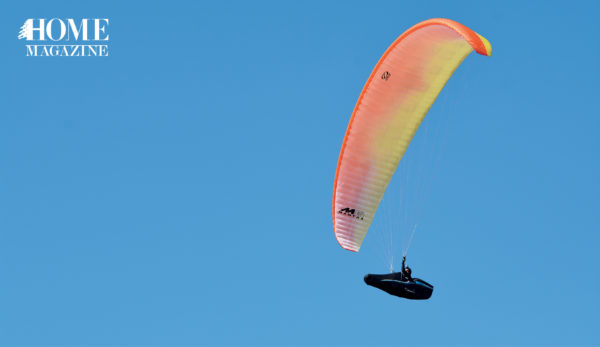Photo by: Atanas Kan
Lebanon’s first ever competitor in the Winter Olympics is one of the few athletes in the world to ever compete in both the Summer and Winter Games. Representing Lebanon in four Olympics so far, she is also the fastest woman in Lebanon, being the top Lebanese female in the past three Beirut Marathons and holder of the national record for marathon.
In the Windy City – Chicago – Chirine Njeim rises before the sun. She packs her dress and shoes, make-up and shampoo in her backpack, laces her running shoes and heads out the door for a 14-km run to work. At the end of the workday, she runs another 14 km HOME. Summer, winter, spring and fall, five days a week, whatever the weather, Njeim clocks 193 km (120 miles) a week. She’s training to qualify for her fifth Olympic competition, the women’s marathon in the 2020 Tokyo Olympics.
Rare is the athlete to be the first ever competitor from her country in the Winter Olympics; to compete in both Winter and Summer Olympic Games; and to take up marathon running as an Olympic competitor at the age of 31 – while working full time!
In a recent interview with HOME, Lebanon’s Olympic star shared her story.
How did you become so interested in sports?
It all started with my family – Mom and Dad are very active. Every weekend, every vacation, we were in the mountains. In the winter, we were skiing in Faraya. In the summer, we were hiking. I’m very lucky to have a family like mine.
I learned to ski when I was 3 and loved it immediately. I would always go as fast as possible and had no fear. At first, everyone would pass me because I was so small and light, so I’d put rocks in my jacket to give me extra weight.
I remember coming HOME from school and watching skiers on TV, especially Alberto Tomba (the Italian World Cup Alpine ski racer who dominated the sport in the late 1980s and ‘90s).
Where did you start your training?
I started at Faraya Mzaar Ski Club. When I was 12, they told my parents I had potential and that I should go outside for training and suggested Annecy, France, where I could train with a personal coach and compete in the junior racing circuit in Europe.
Sending a 12-year-old to live abroad for a sport is definitely not something people generally do, especially those from tight-knit Lebanese families. Relatives kept saying, ‘Why would you do this just for skiing?’ I am so thankful my parents supported my dream.
“I learned to ski when I was 3 and loved it immediately. I would always go as fast as possible and had no fear. At first, everyone would pass me because I was so small and light, so I’d put rocks in my jacket to give me extra weight.”
What was it like to train abroad at a young age?
I didn’t realize what I was signing up for. Mom went with me the first month, so it was like a vacation. When she left, reality hit. I had no friends there. I was living with the coach and his wife. I’d cry over the phone, telling Mom I wanted to go back HOME. It was hard for all of us.
You made another big move to the United States when you were 14. Was that difficult?
The 2002 Olympic Games were coming up. My family saw that the Rowmark Ski Academy in Salt Lake City, Utah, trained on the same hill where the Olympics would take place.
It was a great opportunity, but I had to restart every aspect of my life from scratch – language, culture, friends.
Being a francophone, English wasn’t my strength, so at first I struggled. People spoke so fast.
I eventually caught on and skiing became my routine. Every day from 8 a.m. to 1 p.m., I had school. Then we’d drive to Park City and train until 5 p.m.
How do you approach training?
I am a planner. I set a goal. Then I set a plan and follow it. I build confidence. There are no secrets – just train hard; you’ll get out what you put in. It’s simple.
You faced some serious challenges before the 2002 Winter Olympics. How did you overcome them?
I had a lot of ups and downs. First, two years before the Games, I tore my ACL (anterior cruciate ligament, which controls knee movement). The only option was reconstructive surgery. Then I caught double pneumonia and was hospitalized for a month. I couldn’t even walk.
I was so hard on myself. I did everything I could to get back in shape, but I took everything to the extreme. I tried to eat healthy – greens and salads; I developed anorexia. A year out from the Games, I was underweight. I had to get up to 100 pounds to compete. Mom came and we saw a doctor and a nutritionist. Motivated as I was, it was still hard to eat.
When you’re in it yourself, you feel like you are the only one struggling. You don’t realize other competitors have their own problems. Still, looking back, I don’t know how I did it.
Tell us about your experience at the 2002 Winter Olympics.
There were two of us there for Lebanon. I got to carry the flag. I competed in slalom and giant slalom. It is so special to me to represent Lebanon. Even though I qualified for the U.S. Olympic trials and the chance to be with a well-equipped, well-supported team, I will always represent Lebanon in the Olympics. I want to represent Lebanon.
Between your first two Olympics, you went to the University of Utah. How did you like being on a university team?
Joining the team was relaxing and enjoyable. When you’re on a team, you’re supporting each other. Afterward you’re out celebrating with your teammates and laughing about all this. I had always been so focused. Since I was 13, I had been so strict about my schedule. This was fun.

Photo by: Ronny Kamal
You went on to compete in the 2006 Torino and the 2010 Vancouver Winter Olympics. Tell us about them.
I had more events in Torino. In addition to the slalom and the giant slalom, I competed in the Super G and downhill. It was a great experience.
At my second Olympics, I started realizing what I didn’t have that other athletes did – a coach, massages, someone to carry my skis. As a solo athlete at the Olympics, I even had to do my own ski maintenance. I couldn’t give them to technicians. Also, representing Lebanon means I have less of a fan base and financial support than other athletes in countries where there is generally more exposure to and priority for the Olympics.
In Vancouver, although it is one of my favorites, I thought it was going to be my last Olympics. I had met an amazing guy, married him and I was ready for the next steps.
Racing in the downhill event was new for you. What is it like?
Downhill events are kind of crazy; you are going 105 kilometers per hour across snow and ice. Before competing, you have two days of training runs to study the line, get the course, visualize and memorize it so you know exactly where you are going. Then just go and trust your direction. There are blind spots after the jumps, gates you can’t see. So visualizing the line and the direction to take during the race is very important. You develop muscle memory, then you just have to trust it and go with it. Knowing where to go without seeing what is next is what makes downhill so interesting and exciting.
Not a lot of thinking goes on during the race. Good downhillers are very confident. They know exactly what they want to do. Once you’re out of the gate, you disconnect from your head and just go.
“There are no secrets – just train hard; you’ll get out what you put in.”
After being in three Winter Games, you decided you were done with the Olympics; so how did you end up training for the Summer 2016 Games?
I moved to Chicago with my new husband, Ronny Kamal. Ronny is a second-generation Lebanese-American. There are not enough good words to describe Ronny. He is caring, loving, hardworking and extremely supportive. We met in 2009, flying from Dubai to the U.S. We married in 2012 and had settled in Chicago, where Ronny works as as an executive for the global management consulting and professional services firm Accenture.
I had no intention to pick any sport. I just wanted to be a regular person. I was running on the path by the lake front
during the day, learning the city, and in the evenings, telling my husband what I saw. I could see so much more when I was running. I loved it.
Just for fun, Ronny and I decided we could do the Shamrock Shuffle, an 8K run through Chicago with about 40,000 people, in the spring around St. Patrick’s Day. An 8K was the longest race I had ever run! After the race, I was so tired! But we got excited, thinking let’s do the 2012 Chicago Marathon. We didn’t realize what it took to run 42.195 km. We did it! Me in three hours and seven minutes, and Ronny in three hours and 40 minutes.
When he crossed the finish line, he wasn’t sure if he’d do another, but I loved it. I could have gone farther. I knew there was more in me. I started connecting with running clubs in Chicago and meeting people, training and building my skills in this new sport. I registered for the next one.
How is running different from skiing?
With skiing, you are by yourself, racing against time. In running, everybody is in front of you. You see them right there, and you either push or stay in that position.
And running is nonstop. You are always in training, all year long. And you can run everywhere with only your running shoes. That is something I love about this sport. Skiing is expensive and is a process.
And thanks to the Beirut Marathon installing a culture of running in Lebanon, now people understand what I’m doing. It wasn’t like that when I was an alpine skier; now they say, ‘Wow, she really trains hard.’ And now with social media, more people are into it. In Lebanon, I go on TV, I train with kids. It is all so new. I have a big support group.
I also have a lot of support from my boss, who is a big runner, and colleagues from work.
You’re a regular at the Beirut Marathon. What do you like about it?
I go to Lebanon annually to participate in the marathon. It is a massive event, a happy event. It is great to see Lebanese all gathered and running in the same direction.
The president of Beirut Marathon, May El-Khalil, has organized a race for youth in recent years and she asked me to be involved. I spent a day with a group of young runners. It was so interesting to hear their questions – the ‘how can I?’ questions. I love that part of the sport, to inspire others. In a country where sports are not a big priority, I am happy to encourage kids to be what they want to be.
What’s next?
I’m training with my Chicago team – Second City Track Club – for the 2018 Chicago Marathon and for the 2019 Houston Marathon, the latter serving as a qualifier for the 2020 Tokyo Summer Olympic Games. I’ll continue to train hard to reduce my race times so I can proudly represent Lebanon at the next Olympics.
Quick Facts About Chirine Njeim
– Birthday: Oct. 4, 1984
– Hometown: Antelias, Lebanon
– Parents: Raymond and Najah Njeim
– Youngest of four children
– Attended Campville and Val Pere Jacque schools in Lebanon
– Attended high school and trained at Rowmark Ski Academy in Salt Lake City, Utah
– Bachelor’s degree in Human Development and Family Studies from the University of Utah
– Lives in Chicago, Illinois, U.S.A.
– Works at Livongo Health, a healthcare technology company focusing on diabetes management and care
– Married to Ronny Kamal, a second=generation Lebanese-American executive at Accenture and Chirine’s biggest fan
Njeim’s Record
– Winter Olympic Games, Alpine skiing: 2002, 2006 and 2010
– Chicago Marathons: 2012– 3:07:00 (Rank: 123) ; 2013 – 3:05:40 (Rank: 129) ; 2014 – 3:03:53 (Rank: 158) ; 2015 – 2:46:41 (Rank: 30) ; 2017 – 2:39:21 (Rank: 19)
– Beirut Marathons: 2015 – 2:49:23 (Rank: Top Lebanese woman and fifth overall) ; 2016 – 2:54:12 (Rank: Top Lebanese woman and fourth overall) ; 2017 – 2:45:02 (Rank: Top Lebanese woman and seventh overall)
– Houston Marathon 2016: 2:44:19 (Rank: 20)
– Rio Summer Olympics 2016: Marathon – 2:51:08 (Rank: 109)
– Mediterranean Games 2018: Half Marathon – 1:19:08 (Rank: 5)

































